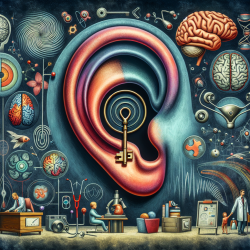Introduction
As practitioners dedicated to improving children's auditory health, we must continually refine our methods based on the latest research. The study titled "Reference values for psychoacoustic tests on Polish school children 7–10 years old" offers valuable insights into the auditory processing capabilities of young children. This research provides essential data that can help practitioners make informed, evidence-based decisions when diagnosing auditory processing disorders (APDs) in Polish school children.
Understanding the Study
The study involved 94 Polish schoolchildren aged 7 to 10 years, all with normal hearing. The research focused on four psychoacoustic tests: the Duration Pattern Test (DPT), Frequency Pattern Test (FPT), Time-Compressed Speech Test (CST), and Dichotic Digit Test (DDT). The results indicated that test scores improved with age, highlighting the importance of age-specific reference values.
Key Findings
- Age-Specific Norms: The study established distinct reference values for two age groups: 7–8 years and 9–10 years. This differentiation is crucial for accurate diagnosis.
- Significant Test Results: Significant differences were found in DPT, CST, and DDT scores between age groups, emphasizing the need for age-specific norms.
- Cultural and Linguistic Considerations: The study underscores the necessity of using population-specific norms due to cultural and linguistic differences affecting test outcomes.
Implications for Practice
For practitioners, these findings offer a robust framework for diagnosing APDs in Polish children. By utilizing the reference values provided, clinicians can make more accurate assessments, reducing the risk of false positives or negatives. This approach not only enhances diagnostic accuracy but also ensures that interventions are timely and appropriate.
Encouraging Further Research
While this study provides a solid foundation, it also highlights the need for further research. Expanding the sample size and including diverse populations could refine these norms and enhance their applicability. Practitioners are encouraged to contribute to this growing body of research, ensuring that our methods remain at the forefront of clinical excellence.
Conclusion
Incorporating these research findings into clinical practice can significantly improve outcomes for children with auditory processing challenges. By adopting a data-driven approach, practitioners can provide more effective and personalized care.
To read the original research paper, please follow this link: Reference values for psychoacoustic tests on Polish school children 7–10 years old.










